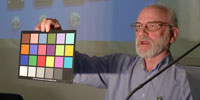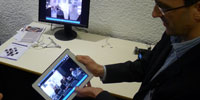The focus turned to cameras, lighting and displays for the opening session on day two of the Production Technology Seminar 2012. A series of presentations provided expert guidance on the grading and measurement of both cameras and displays, while colorimetry expert Alan Roberts demonstrated clearly the impact that the increasing use of LED lights is having in TV production. Even in the less than ideal environment of the conference room it was clear how different lights with the same colour temperature but different spectral content can change the way a colour test card appears.
The first session was brought to a close with a glimpse of a possible future scenario where tablets, which are increasingly popular, could be used as a production tool. The demo by the BBC’s Peter Brightwell was a popular draw during the coffee break.
 |  | |
| Alan Roberts demonstrating the impact of LEDs and Peter Brightwell demonstrating the use of a tablet as a production tool | ||
The topic of Quality Control was next up today with a couple of use case presentations from Italian broadcaster RAI and Norway’s NRK illustrating some of the challenges faced by broadcasters in managing and quality checking the vast numbers of files involved when broadcasters transition to a file-based environment. One of the clear messages was that while automated systems are improving and can help greatly, human intervention will continue to be necessary in future.
It was the turn of the audio folk after lunch, with a series of lively – and loud! – presentations on the latest developments in the field. Topics addressed included techniques to enhance dialogue over background audio and the challenge of delivering 5.1 audio when many viewers continue to use stereo speakers. In a presentation where he played a number of sample audio tracks in the room, RTVE’s Gabriel Solsona clearly demonstrated some of the benefits that can accrue if attention is paid to coherence and alignment awareness in sound production.
The final part of the afternoon was taken up by a set of parallel tutorials. Delegates could choose from tutorials covering file-based workflows, camera measurement tiering, hybrid radio and SOA (service-oriented architecture) and FIMS. A well-earned cocktail reception brought day two to a close.
